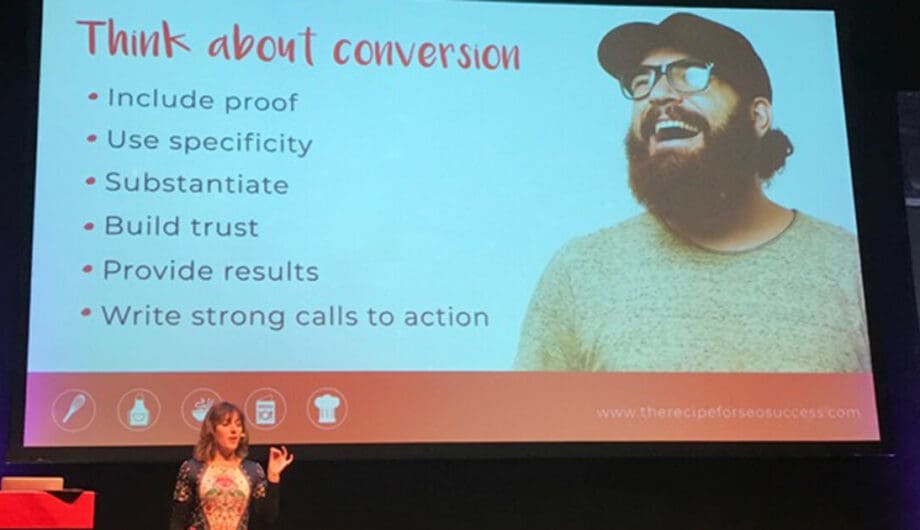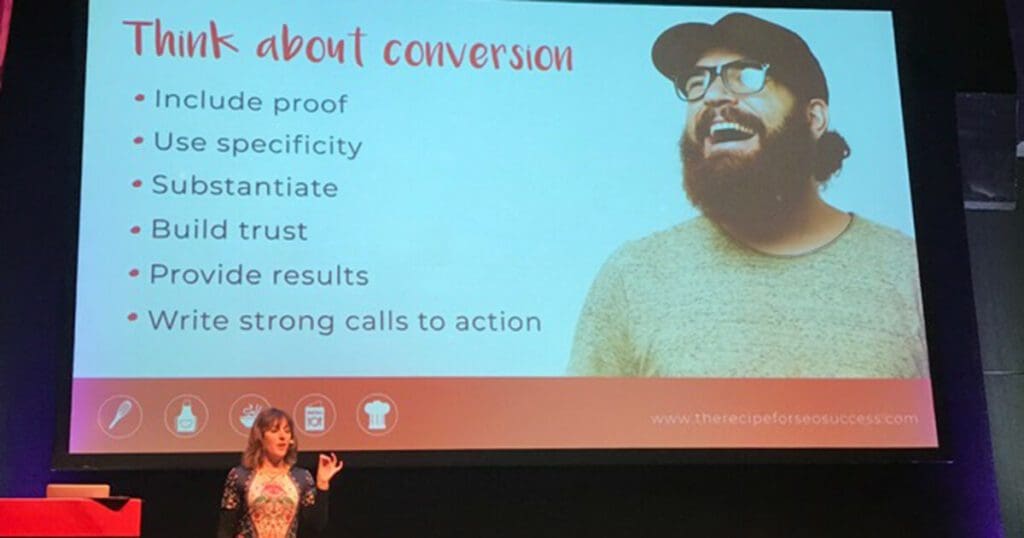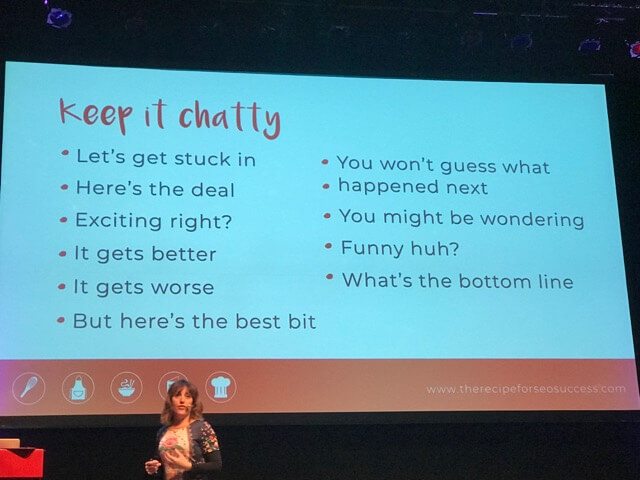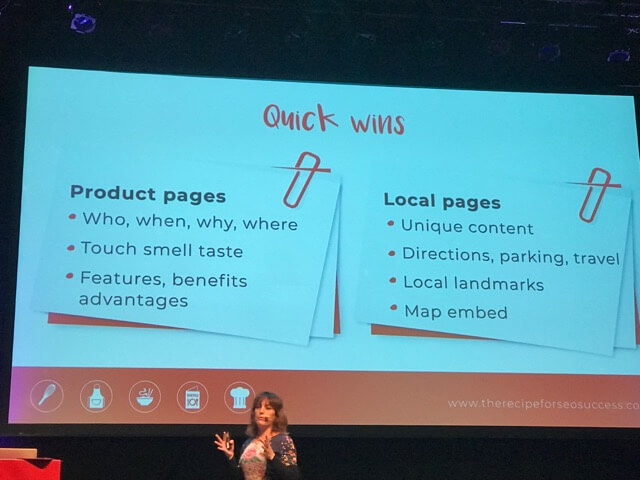
Some of the Sumy Designs team recently attended YoastCon 2019 in Nijmegen, The Netherlands. We heard many great speakers and gained lots of new knowledge.
One of the speakers who stood out for me was Kate Toon from Australia. She has an online SEO course therecipeforsuccess. Her presentation was about how to write content that gets people to want to act.

Steps for creating conversion copy
1) Craft your unique selling proposition (USP)
Take some time to figure out why/what makes you better than anybody else. Can you make a specific claim? Make a promise about your product or service?
2) Who is your audience?
Kate talked about knowing the BDF of your audience.
- B = Believes (What are their preconceived beliefs?)
- D = Desires (What are their deepest desires?)
- F = Fears (What are their darkest fears?)
By knowing your audience and what they think, you can answer their questions and concerns while marketing directly to your customers. For example, if you own a pool building company, perhaps you know your customers have feelings (beliefs) about having a backyard pool. They imagine all the fun they will have with their children’s friends and their neighbors. They really desire an inground pool that complements their existing house and yard (perhaps with a swim-up bar?). However, they are afraid of how much it will cost. They also worry about the liability of owning a pool in case somebody gets hurt or drowns.
If you can answer all of those different desires and fears and correct or address any preconceived beliefs, then you have already done most of the sales job.
3) Understand Awareness Levels
People come to websites for all sorts of different reasons and with different levels of awareness about your product or services.
- Problem Awareness: These customers know they have a problem, but don’t know much about it. They need more details about who, what, when, and how.
- Solution Awareness: These customers realize a solution exists for their problem, but are still researching options for the best resolution.
- Product Awareness: These customers are aware of a product that exists to solve their problem, but are not brand loyal. These customers are looking for your sales page to compare you to your competitors.
- Branded awareness: The most aware (loyal) customers are those who are searching for you by your business or name.
4) Searcher Intent
This ties in with step 3. Knowing your searcher intent mimics their awareness levels.
- Informational: These customers are seeking more information about a product or service. They are gathering knowledge and are not yet ready to buy.
- Investigation: These customers have decided on which product or service they need but are comparing quality, reviews, price, etc.
- Transactional: These customers are looking to make the best purchase.
- Navigational Intent: These customers are looking for your specific product or brand name.
5) Keyword Research
Now that you’ve spent time thinking about your audience and all the different ways they might reach your website. It’s time to dig into keyword research. You want to be sure your copywriting is using the same words your audience is using. There are several free tools you can use to generate ideas, such as Answer the Public, Google Ads Keyword Planner, Google Trends, Keywords Everywhere, and UberSuggest.
6) Start Writing
This is where you create a “skeleton draft.” Address your customer’s awareness, interest levels, desires, and give them an action step to take.
Writer’s block? Write in a white font on white paper so you can’t see your work. This prevents you from getting bogged down in wording and other errors. When you are done writing, go back and change the font to black and then make the corrections.
Be sure your writing addresses the problem. Go ahead and make a list of pain points your potential customer is feeling. Next agitate your reader. Tell them what will happen if they don’t solve their problem. Finally, give them a solution to the problem. Make sure the solution is a call to action to get them to take the next step down the buying funnel.
7) Write for Humans
Finally, make sure your writing is for actual people. Use contractions, avoid cliches. Be conversational. Be playful. Use the customer’s language.
- Check your structure. Does your blog post or website page have a beginning, a middle, and an end?
- Did you use subheaders to break up the content?
- Do you have just one thought per paragraph?
- Did you keep your paragraphs short with just 3-4 sentences in each paragraph?
- Did you use bullet points?
Here are some other tips:
- If you don’t use the Yoast plugin, you can use the Hemingway App to check for readability.
- Keep it chatty (here are some phrases Kate uses to make text flow better):
- Here’s the deal
- Exciting, right?
- It gets better
- It gets worse
- But here’s the best bit
- You won’t guess what happened next
- You might be wondering
- What’s the bottom line

8 ) Think about Conversions
To get your customer to take the next step and sign up for your email, fill out the form, or purchase the product, include proof about why your product or service is best.
“Over 1000 Yelp customers can’t be wrong”
- Be specific about your product.
- Substantiate your claims
- Build trust
- Provide results
- Write strong calls to action. Instead of having a CTA button saying “Click here”, change the text to “I want to …”
Quick Wins:
Product Pages should answer the who, when, why, and where questions. Use descriptions so readers can touch, smell, or taste the product. Explain the features, tell the benefits, and list the advantages of your product or service.
Local Pages should have unique content. Give directions, tell about parking, use local landmarks, and embed a map.

In Conclusion:
As the search engines strive to give searcher the best answers to their problems, those websites which take the time to truly figure out their customers, plan for the journey through the buying funnel, and have really good content are the websites which will rise to the top of the search results.
Want to know more about our SEO services? Request a quote today.
Elise Nester
Elise is in charge of helping clients with website support and maintenance requests including plugin and theme changes, content updates, general troubleshooting, and more.
